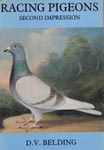 Recommended
Method
Recommended
Method
Measure out I oz per bird of top quality corn, varying between maples and mixture. All corn should be weighed. Sometimes I have my birds out several times a day, and on each occasion I would call them in with a few grains from the corn tin, but these grains are taken from the amount weighed out, and therefore no matter how often the birds are fed they will not get more than that I oz (28 g) per head. To this add a handful of linseed. My birds would receive linseed every day, some days more than others but never less than a handful. This is wrong according to authors and experts on pigeons, for they state it is fattening and brings on the moult, but I can only say that my birds have been having this seed daily more or less from birth and there have been no harmful effects, indeed I have had all my birds home on hard races when some fanciers have hardly seen a feather! Facts speak louder than theory and I would advise all to give their birds linseed each and every day. This seed is apparently the only one to be able to break down the amino acids to get full nourishment from the corn given as a main meal.
It is most beneficial to add maize to the diet once the young in nest are nine to sixteen days old, in fact in most lofts maize is added right from the birth. The O.B.'s give the best guide; notice which grain they choose when having the main meal, You will probably find maize is much preferred around the nine day mark than before, but let your birds guide you, for they know which is best for their young.
Although my birds receive scraps of anything which I think they will enjoy, I will not under any circumstances give them seeds of any sort except linseed. Sunflower is excepted, but all others are taboo. Millet, rape, hemp and so on, are, in my opinion, fattening. Manufactured conditioning seeds and mixtures are also unnecessary: there is no need for them when a varied diet is given. A little cheese will provide all that these seeds will, for it is packed with vitamins and body building elements and will not cause the fat that these seeds seem to do.
Hampering Days
On hampering days a normal feed should be given to the birds before 10 a.m. this will allow time for it to be digested. If fed later than this time the corn will remain in the crop and this gives an opportunity for the bird to be sick during all the upheaval that takes place before getting to the race point. Some fanciers only give a very light feed on basket days just to keep them hungry, but a full feed before 10 a.m. is a better decision to make.
Giving the Feed
It is best to allow your hands to come into contact with the birds at feed time. After a few minutes of this treatment take a handful of corn and allow a few peas to drop and with a fist clenched encourage them to peck at the hand to take food. This little game takes five or ten minutes, then place most of the peas into the tray and stand and watch them eat. Sometimes they finish and go to the drinker, at other times they stand around waiting for the remainder of the ration. When I only had the four birds I fed the cheese or pastry to the birds individually, with a full kit I would have them chasing all over the lawn for it. All scraps of food previously mentioned were given my stock birds.
By feeding my birds in this manner, making a game of the first few minutes of feed time, I was getting the birds used to it, and as my hands always touched them they got used to this also. When my birds return from races they expect my hands to hover around them as they pick up the few grains put down for them, it is then a very simple task to pick them up and take their rubber and clock in, and as I always fed by the door it was seldom I ever had to enter the loft to catch the bird to clock in, all I used to do was bend down and pick them up. Without the birds knowing it, I actually trained them to feed at the door and to accept my hand around them for the first few minutes of feed time. Come race days this simple training saves valuable seconds in clocking in; it also saves me scaring the life out of returning birds by chasing them all over the loft to get the rubber off. Try and imagine the feeling my birds thus get on their return compared to those of other lofts, which are hastily chased about the loft to be caught.